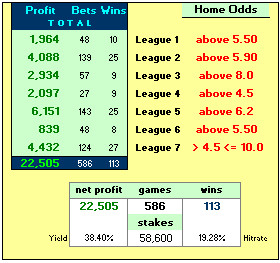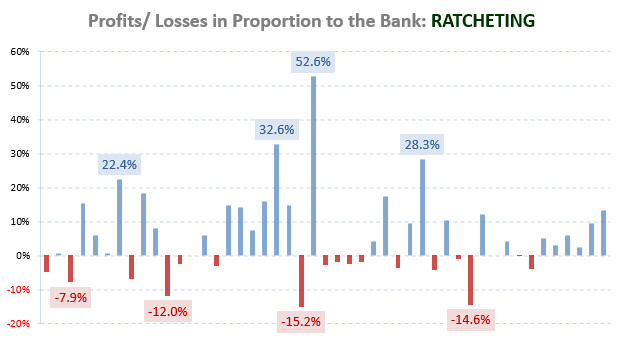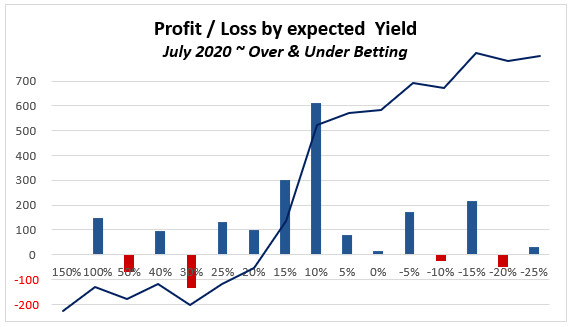
Finding the The Market’s Inflection Points
The art of bookmaking is to counter-balance the pressure of market forces and oscillate between probabilities.
 Image: archideaphoto (Shutterstock)
Image: archideaphoto (Shutterstock)We continue with the example:
Home wins (Favourite): 56.48% = odds of 1.77 [mathematical inflection point]
Home wins (Underdog): 22.77% = odds of 4.40 [mathematical inflection point]
Now remind yourself: Bookmakers have to ‘play’ the market situation in order to balance their books.
They know that many more punters will bet on the favourites rather than on the underdogs and must therefore set their odds (and change them continually during the ante post) to ensure sufficient action is taking place on both sides of a bet.
Using the HDA Tables it is possible to find the market’s inflection points. The tables simulate five full seasons’ profits/losses when betting on every single match.
The actual inflection points (seasons 2009-10 to 2013-14) in the EPL were as follow:
Home wins (Favourite): 66.67% = odds of 1.50 [the market inflection point odds]
Home wins (Underdog): 16.13% = odds of 6.20 [the market inflection point odds]
This means that the sum total of all bets at odds between 1.50 and 6.20 returned a LOSS to the bettor.
You now know the secret that betting on all EPL matches where the home team to win was priced below 1.50 or above 6.20, returned profits when betting uniformly on all matches to be home wins in this league.
To find the market’s inflection points the HDA Simulations play a crucial role. The tables are developed with a view to finding these inflection points. However, you must be aware that all inflection points in each 1×2 bet type differ from league to league.
Backing the Underdog when playing at Home
To reiterate the findings… the mathematical inflection point for EPL favourites playing at home was 1.77, but the market’s inflection point was 1.50. This means that favourites playing at home were clearly under-priced to win.
For underdogs playing at home the mathematical inflection point was 4.40, but the market’s inflection point was 6.20. This means that underdogs playing at home were clearly over-priced to win.
Arriving at these findings, the bettor has the choice between backing favourites at home in the EPL at odds below 1.50, or backing underdogs at home at odds above 6.20. Both strategies return profits.
Designing a Portfolio for the new Season
The image below shows a selection of seven major European leagues with their inflection points for backing underdog wins at home. (Click on the image to enlarge to full size and show additional information – opens in a new tab).
The English Premier League is marked as ‘League 5’.
The other six leagues (in no particular order) are:
• Belgian Jupiler League
• German Bundesliga 1
• English Championship
• French Ligue 1
• Dutch Eredivisie
• Scottish Premiership
Reading the table… backing the underdog at home over the last five seasons would have resulted in the placement of 143 bets in the EPL at odds above 6.20.
Only 25 bets would have won but these would have returned a profit of 6,151 units (from 100 unit stakes).
The entire portfolio (using findings from the last five seasons) contained 586 games of which, 113 won (19.28% hit rate).
The Yield was 38.40% over five seasons (22,505 units profit from 586×100 unit stakes).
Distributions do not change radically from one season to another. It is pretty safe to assume that next season will follow a similar pattern (unless there is a fundamental change to the structure of a league), and a portfolio compiled from these seven leagues should therefore return a profit.
It is expected that next season this strategy will contain approximately 117 bets, and by placing bets consistently on each underdog to win at home at the odds displayed should return 4,500 units profit (from 100 unit stakes).
Remember, of course, the expected hit rate is only 19.28%.
Portfolio Size Matters
The previous chapter explained how to identify a betting portfolio for betting on the underdog to win at home. The expected hit rate is only 19.28% and this means only one out of five bets will win. Losing streaks may quite conceivably add up to more than four games in a row, but the long-term yield should always be around the 38.4% mark. However, this portfolio, although encompassing 7 leagues, only contains approx. 117 bets for the season.
There are normally 38 match days in a regular season (max. 46 in some leagues), and if a portfolio only contains 117 bets, this means that there will be only 3-4 bets for each round. This is far too volatile, and will put even the most patient person under pressure because unfortunately, winning bets do not line up nicely.
The wise approach is to select other bet types to complement and support your football betting endeavour for a more balanced portfolio – ones with a higher hit rate, paying less attention to maximising the yield. Combining these strategies will smooth out the peaks and troughs in the profit/loss curve and lead to a more stable betting bank.
Considering the restriction an individual bettor has (i.e. time and money), the minimum size for a betting portfolio should be around 30 bets per week.
30 bets x 38 rounds = 1,140 bets in total.
Therefore, the 117 bets discussed in the previous chapter comprise just a tenth of the final portfolio size.
Compile Your Own 1×2 Betting Portfolio
System betting using a portfolio of strategies from several different leagues is for most people a difficult subject to master.
The following series of key articles is aimed at helping you fully understand the fundamentals of profitable 1X2 portfolio betting using our revolutionary HDAFU Tables.







Dear Elena,
hope you’re doing well. I have the following somewhat interesting questions no one has asked before if I’m correct:
(1) The inflection Points of how many previous seasons in your opinion would be optimal to build your strategy on? You’ve mentioned previously that you think that 6 are too many.
(2) When the new season starts, do you discard the oldest season and include the Inflections of the last season?
Thank you for your valuable thoughts on that!
Florian
Hi Florian,
as I already said, 6 seasons are probably too many. There are too many changes in the format of the leagues, different teams competing, or now, this virus affecting the 1×2 performance. There is always something going on. Five seasons for the Inflection Point graphs proved to be ideal and it certainly shows trends. However, if you calculate individual matches then you can always check your calculations by using the last 25 matches (that is 1.5 years). Anything less it’s too little and statistically speaking, too much noise.
To your (2) question: Yes, when the new season starts you drop the oldest season and replace it with the season that just finished.
By the way, currently, the Cluster Tables seem to perform much more reliable than the HDAFU tables. Playing without crowd hasn’t so much affected the total goal count but it somewhat seems that there are many more away teams currently winning than previously. Regarding odds and distribution, Rob is currently looking into that and writing on an article.
Good luck!
Soccerwidow